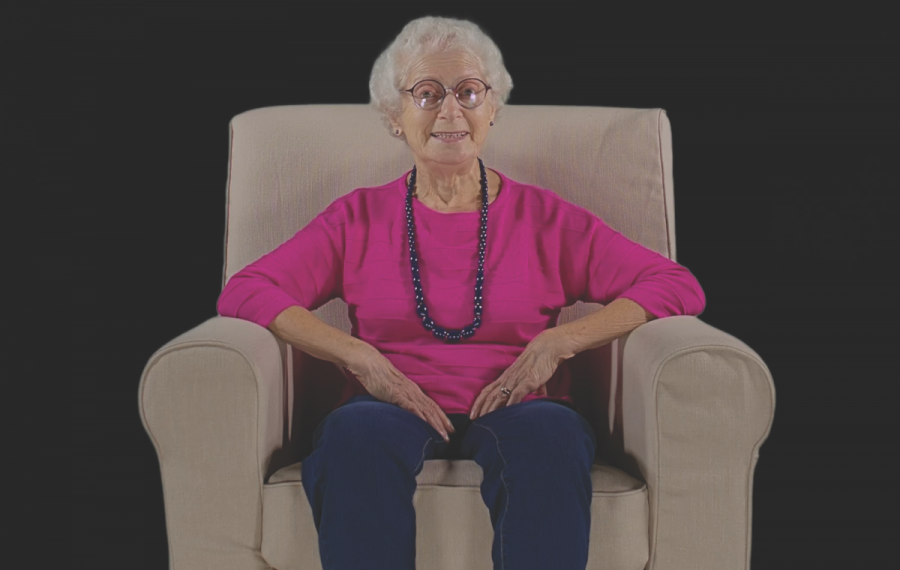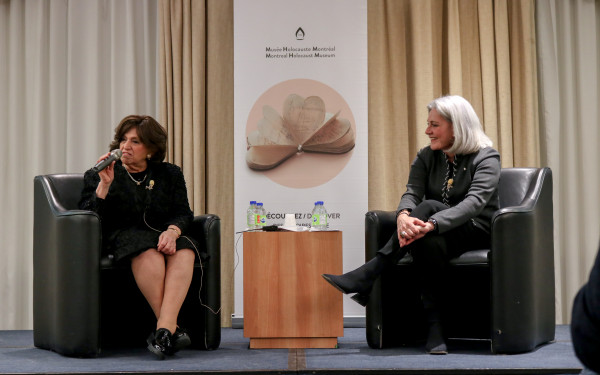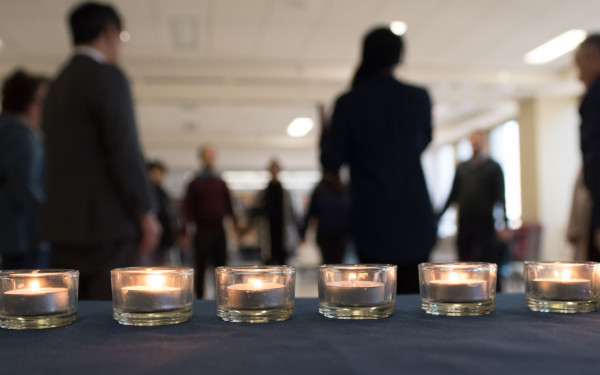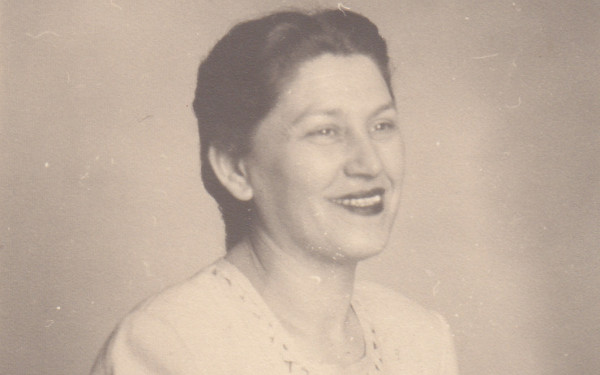Dimensions in Testimony – The Most Interactive Holocaust Exhibit to Date
Virtual technology provides access to conversations with Holocaust survivors for future generations
Eszter Andor’s day began in the hours of the early morning leaving Montreal to pick up Holocaust survivor Marguerite Quddus from her residence in Longueuil – a familiar trek the pair would make daily over the next five days.
Upon returning to Montreal, the ladies enter a vast warehouse – their frames small amidst the large green screen backdrop that stretches from floor to ceiling. The remainder of the walls are covered in dark tapestry so no light can peer through.
Quddus walks over to the centre of the room in her blue jeans and beige kitten heels to sit in a plush cream-coloured chair. She wears a long necklace that hangs over her bright fuchsia shirt. Her white hair and dark-rimmed glasses are illuminated by a warm glow from the tall lights that tower over her chair.
Andor walks over to an elevated black chair directly facing Quddus surrounded by cameras and wires - her view of Quddus slightly obstructed by the large equipment. With a bottle of water next to her, Andor has the University of Southern California (USC) Shoah Foundation’s 700 questions prepared for the new Dimensions in Testimony exhibit.
As they sit face to face, Quddus recollects her personal experience of the atrocities of the Holocaust throughout the long and arduous days to Andor.
“It was a really intense experience,” said Andor, oral history and remembrance coordinator at the Montreal Holocaust Museum.
Dimensions in Testimony (DIT) is a three-dimensional interactive exhibit currently in its beta-testing phase at the Montreal Holocaust Museum (MHM) presented in French during the first two Sunday from June until August. The exhibit allows attendees to have conversations with pre-recorded video images of Quddus about her experience as a Holocaust survivor - providing a unique opportunity for Holocaust education as critical gaps in Holocaust awareness and knowledge remain.
Around 15 per cent of all Canadian adults are unaware or not sure if they’ve heard of the Holocaust, and 89 per cent of all Canadians have never visited a Holocaust museum.

Approaching the MHM’s entrance, attendees of all ages are directed down the brightly lit hall
before entering an intimate carpeted meeting room to the left of the hallway. There are four rows of chairs facing Quddus’ image displayed on a thin black screen that stretches several feet high.
Museum interpreter Antoine Simonato sits at a small table directly next to Quddus’ image with a control panel and a microphone.
Simonato welcomes attendees as they steadily enter the room and take their seats. After introductions subside, the 45 minutes of interactive conversation between attendees and Quddus’ image begins.
First, attendees must raise their hand to indicate they are prepared to ask Quddus a question. Simonato points to the attendee and the room falls silent as he registers the microphone. When Quddus’ image hears the question, she pauses for a few seconds before replying – this is normal because the technology needs a few moments to register her response.
Quddus’ response depends on the way a question is phrased – the wordier an attendee’s question is, the less likely Quddus is to give a direct response. When this occurs, Quddus’ image responds with, “I’m sorry I don’t understand your question,” if the technology believes the question formulated does not make sense.
Occasionally, Quddus’ image has difficulties recognizing certain words. Simonato then opens the chat on the right side of the screen and flags the response. From there, the USC Shoah Foundation will be notified of errors and correct them.
Questions over the 45-minute interval range from Quddus’ experience surviving the Holocaust, to her hobbies such as her fondness of drawing.
When responding to questions about her father, Quddus’ image displays a noticeable sadness as her eyes begin to well. “Those questions were difficult for Marguerite,” said Andor.
In August 1941, Quddus’ father was deported from Paris to the Drancy transit camp and then to Compiegne. After Compiegne, he was transferred to Auschwitz where he was murdered by the Nazis in April 1942.
Quddus and her sister survived by living with several families and in convents hiding their Jewish identity from 1942 to 1945. In 1945, the girls were reunited with their mother who survived by living under a false identity in Lyon, France.
“The testing is an emotional experience,” said historian and educator Antoine Simonato.
Simonato said he often notices attendees becoming emotional alongside Quddus as she recounts the memories of her father – a man she describes as kind and sophisticated.
Andor believes DIT is different from other Holocaust exhibits because of its ability to mimic direct conversations which inspires more empathy.
There is a clear link between an increase in empathy and video testimonies according to studies. Video testimonies are unique educational resources because they require attentive engagement and encourage empathetic responses- particularly in students learning about the Holocaust.
Holocaust education is a concern in Quebec because the provincial school curriculum does not address the Second World War in detail and Holocaust knowledge is therefore low.
Results from a Leger poll show 53 per cent of Quebecers did not know that six million European Jews were murdered by the Nazis in comparison to 35 per cent of other Canadians. Additionally, more than 61 per cent of Quebecers said they had never read a book about the Holocaust in comparison to the rest of Canadians who had an average of 41 per cent.
Quebec’s history with the Jewish population is complex.
Montreal was once the dominant Jewish metropolis in Canada, but that changed when the possibility of Quebec’s sovereignty emerged. According to a study published by researchers Koffman and Weinefeld in 2011, the rise of Quebecois nationalism and the separatist movement in the 1970s, led to the significant migration of Jews from Montreal to Toronto because of turbulent politics and antisemitism.
Simonato hopes DIT will improve Holocaust awareness and knowledge. He believes this interactive exhibit will be memorable for students and adults.
“If kids come here with at least some knowledge about the Holocaust, they can use that to better themselves, and the way we learn is by doing things,” he said. “Interacting is a way to learn something better.”
It is important to note that Quddus cannot respond to the general history of the Holocaust – she can only answer questions based on her own personal experience.
Parts of the interview process were difficult for Quddus, explained Andor. There was concern over the long days since Quddus is in her late 80s, along with the emotional toll of answering nearly a thousand questions about the Holocaust.
Some of these questions sparked frustration for Quddus.
“I had to tell her not to roll her eyes,” said Andor when asking Quddus if she knew Hitler.
As undesirable as certain questions were, they were a necessary part of the interview process. The USC Shoah Foundation required Andor to cover a wide variety of questions they believed the public might ask.
DIT is on track to becoming a permanent exhibit once the MHM reaches its testing goal. “The museum needs 8000 interactions from testers overall before the exhibit can reach its final phase,” said Simonato.
Once the MHM completes its 8000 interactions for beta-testing, the exhibit will be permanent.
Those attending the DIT testing have high hopes for the exhibit and are noticeably excited to participate in the experience.
“It’s really cool to have access to memories after she’s not here anymore,” said attendee Antoine Maboli.
DIT has conducted 50 interviews in English, French, German, Hebrew, Hungarian, Mandarin, Russian, Spanish and Swedish across eight partnership countries. The exhibit has become permanent in Holocaust museums around the world.
Despite the emotionally taxing and rigorous interview process, the anticipation for the future between Andor and Quddus was palpable at the end of the five days. “It’s exciting,” said Andor. “Marguerite’s story can be told for generations.”
As the 45 minutes of the beta-testing comes to an end, Simonato asks Quddus’ image a final question.
“Marguerite, why did you want to tell your story?” he asked.
“For justice,” she said.


_600_832_s.png)




